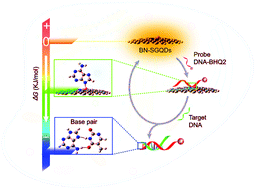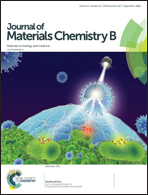Boron and nitrogen co-doped single-layered graphene quantum dots: a high-affinity platform for visualizing the dynamic invasion of HIV DNA into living cells through fluorescence resonance energy transfer†
Abstract
High-affinity binding of carbon nanomaterials with nucleobases, which is still a challenge, is the basis for DNA directed assembly and sensing. In this work, boron and nitrogen co-doped single-layered graphene quantum dots (BN-SGQDs) are designed as a high-affinity platform for nucleic acid detection and imaging in living cells, which has been confirmed by density functional theory (DFT) simulation and experiments. Owing to their excellent absorption and photoluminescence ability, the high quantum yield (QY 36.5%) yellow fluorescent BN-SGQDs could act as an energy donor in the fluorescence resonance energy transfer (FRET) process for nucleic acid detection. Furthermore, this BN-SGQD based sensing platform has been successfully adopted to visualize the dynamic invasion of human immunodeficiency virus (HIV) DNA into HeLa cells. The high-affinity platform has shown potential for biosensing in complicated biological samples.



 Please wait while we load your content...
Please wait while we load your content...